
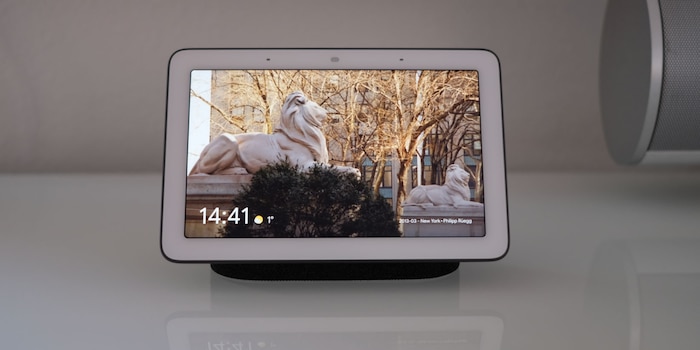
Google Home Hub: more than just a smart photo frame?
Voice assistants always find a way to make their mark. After smartphones and smartspeakers - i.e. connected phones and speakers - it's now the turn of smart displays. The Google Home Hub is just such a display, and it promises all sorts of practical features, more than I expected.
To tell the truth, I don't need yet another gadget in the house: my Philips Hue smart bulbs aren't networked, they do what they're basically designed to do, light up, but it's expensive per bulb in these conditions; the Chromecast has become superfluous, with every device now integrating streaming technology; my Google Home turns itself on even if I haven't said "OK Google". Perhaps this is a desperate cry for my attention. I prefer to turn my attention to the Google Home Hub, which I brought home in good conscience. True, I only borrowed the device for testing purposes, but I'm perfectly willing to buy one for myself.
What is the Home Hub?
Google Home home devices (Home, Home Mini, Home Max) are nothing more and nothing less than speakers with Google Assistant running on voice commands. The Home Hub is the first member of the family to incorporate an extra screen, allowing you to play music, answer questions, view photo albums and play YouTube videos.
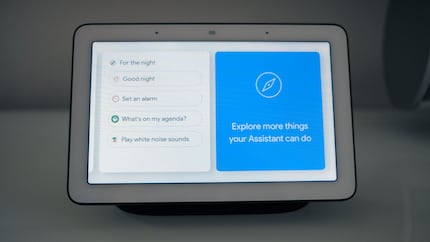
At the moment, the Home Hub can only be imported, which means that English is the only language available. However, it is due to go on sale in 2019, with other languages to follow. In the meantime, you'll have to make do with English. But that's only a lesser evil, as Google Assistant doesn't have the same functionality in German.
Cute, discreet and bug-free
The Home Hub is available in four colours. As well as black (charcoal), the base and screen edge come in grey (chalk), turquoise (aqua) and pink (sand). Aesthetically speaking, I like this little device, judging by the photos I'd seen. The relatively wide edges of the screen are more discreet than I expected. In the home, the Home Hub knows how to be discreet, but depending on the colour, it could also stand out.
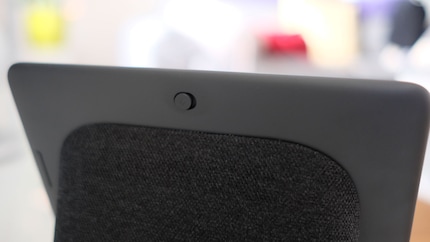
Although the Home Hub supports Google Duo - the video chat app - there is no built-in camera. The latter would have been of no use to me anyway having put the tablet on my TV stand at knee height. Besides, I wouldn't want to be constantly watched. With Google, you're always monitored, which is more than enough. However, this function can be deactivated using the button on the back of the screen.
Connected photo frame and jukebox
The Home Hub can be set up in a matter of minutes: simply plug it into the mains, download the Google Home app onto your mobile phone and complete the installation process. The device is then at the mercy of your verbal attacks. A simple "Hey Google" or "OK Google" followed by a request will operate the device. The built-in Google Assistant works in the same way as it does on a smartphone and performs the same feats with very little variation. With my English, the Home Hub usually understands me first time.
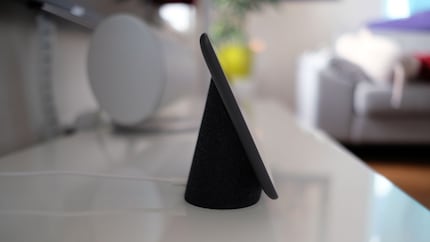
Music, podcasts, audio books, etc. can all be accessed with a simple voice command. The speakers produce powerful quality sound. The device has volume buttons, which can also be adjusted by voice commands.
With the 5.1 speakers in my living room connected to a Chromecast-enabled receiver, I use Home Hub to launch music tracks. To do this, all I have to do is say, "Hey Google, play music on Onkyo". Onkyo is the name of my receiver. I could use the Google Home app to rename it "Mixmastermike" or "Jukebox". I quickly renamed the Home Hub to "Hubby". Incidentally, you can change the name under which the Google Assistant addresses you. "Laserbrain" is unfortunately already taken. 😉
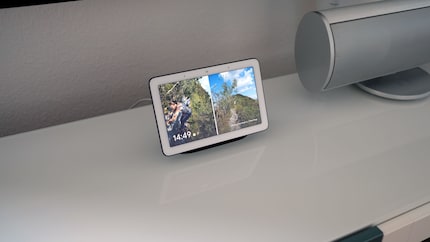
The screen can display different things like the calendar, the weather, the time or photos. It was mainly for this reason that I bought the Home Hub. I've always found electronic photo frames practical, if too basic. Hubby stands out from the crowd. You can choose, from Google Photos, the photos, albums or people you want to display. There's also a brilliant option that automatically selects the best photos of the moment. It's not bad, but my photos illustrating computer hardware reviews are also displayed, which isn't necessarily necessary. Can't remember when and where a photo was taken? Ask Google, it knows the answer. Depending on the display options set, new images are added automatically.
Other people in the same household can also use the Home Hub and display their photos there. After sending my wife an invitation via the app, she was able to add her Google Photos albums. There is also visitor access with limited rights.
More useful than expected
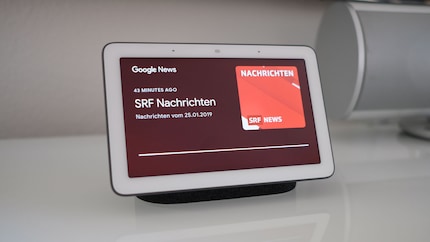
Truth be told, I thought I'd stick with the music control and photo frame. But after trying out all the Home Hub's features, I found myself using many more on a regular basis. Now it reads me the news from time to time. I can choose between Zeit Online, Süddeutsche Zeitung and SRF Nachrichten or, as Google would say, "SRF Nakrigten". Some English-language news portals such as CNN are also available in video format. I can switch them over with a simple command on the big TV.
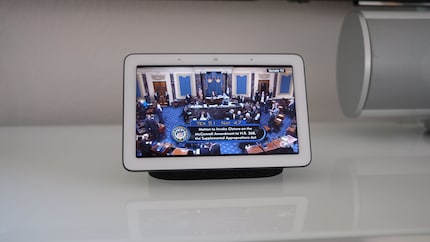
Also, I often use Hubby for googling. For example, while eating or watching TV, I can throw out questions that are on my mind from across the room instead of laboriously typing them into my smartphone like a novice.
Another useful function is broadcasting, provided you have at least two Home Google devices. This allows you to transmit a voice announcement from a smartphone or Google Home device to another Google Home device. This means that if you live in a multi-storey house or a corner flat, you can, for example, call people at the dinner table without having to shout across the whole house. I found the quality of the recording surprisingly poor. I felt like I was ten metres from the microphone, in a container with a megaphone with no batteries.
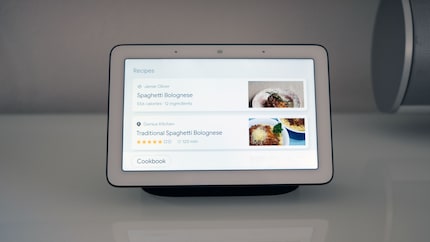
If I had space or money for a second appliance, I'd put it in the kitchen. In addition to the tips already mentioned, the Home Hub helps out in the kitchen. Instead of having to touch the screen of my mobile phone with floury or sticky fingers, the Home Hub displays or reads out a recipe step by step, which can be advanced or retreated by voice command. As the range is limited to AllRecipes and The Food Network - cooking sites in English - this is not at all practical. Units of measurement such as ounces are of no help to me and cooking techniques require me to do some research each time.
In addition, the Home Hub also allows me to control my Philips Hue bulbs. This installation also works via the Home app. However, I prefer the classic switch.
Touch controls
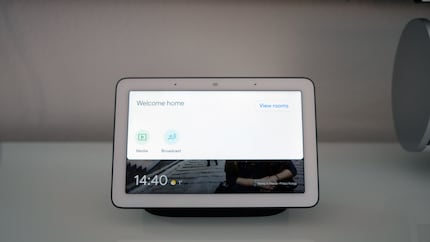
The Home Hub supports both voice and touch control. Swiping from top to bottom displays a menu listing other connected devices in the home; from bottom to top, volume, brightness and settings; from left to right, the clock; from right to left, videos, music, calendar, weather, etc.This last gesture can also be used to play a YouTube video or a new playlist. I advise you to position the device so that you don't have to bend over to use it. The TV stand, as in my case, is not the solution.
Overview
The Home Hub is more useful and reliable than I imagined before the test. Initially, I thought I would only use it as a connected photo frame. Instead, I asked it to play music on my speakers, read me the news or even ask me stupid questions. For its size, the speaker sounds surprisingly good, and the voice control is extremely reliable and fast despite the English constraint. It's rare that the device doesn't understand me.
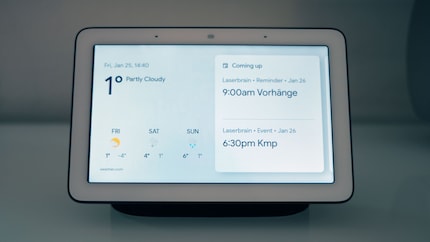
I have a few criticisms for it though: depending on where it's installed, the screen is too small for a photo frame. I deplore certain limitations in functionality, such as only being able to play podcasts via Google's Podcast app, but not via Pocket Casts. However, a solution shouldn't be too long in coming. Another downside? The price. Over 200 francs is a lot of money, especially if you only need a few functions. As the German version has not yet been released, you'll have to wait a little longer. Seasoned Google users with other connected Google Home devices won't be disappointed on the journey.
As a child, I wasn't allowed to have any consoles. It was only with the arrival of the family's 486 PC that the magical world of gaming opened up to me. Today, I'm overcompensating accordingly. Only a lack of time and money prevents me from trying out every game there is and decorating my shelf with rare retro consoles.



